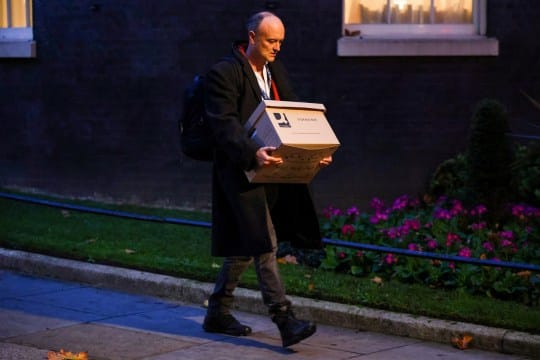Easy Cummings, Uneasy Goings

By Fakhriya M. Suleiman, MA Global Media and Postnational Communications
Dominic Cummings, the now bygone Chief Adviser to Prime Minister (PM) Boris Johnson, resigned from his post on 13 November. According to the Financial Times (FT), Cummings’ premature departure followed a meeting of ‘intense exchanges’ with the PM. Therein, Johnson accused Cummings of ‘destabilising’ the government.
Also present during the bitter exchange of words was another now former top aide to the PM who has also quit. Lee Cain, the ex-communications director, followed suit and resigned the same day as Cummings. The two were said to have ‘briefed against’ the PM.
Cummings and Cain are not strangers to one another. They were close allies and worked together during the Brexit campaign. Cummings is in fact credited for the ‘let’s take back control’ slogan – as seen on ‘Brexit busses’ during the run up to the 2016 referendum vote. The Cummings-Cain exit is reported as being welcomed by some within the Conservative party as a ‘reset’ to enable smoother leadership amid struggles to grapple with the country’s Coronavirus woes and looming end of the Brexit transition period.
“[Dominic Cummings and Lee Cain]… creat[ed] an atmosphere of ‘toxicity’ for having failed to ‘handle personal relations within government optimally.’”
The FT went on to describe the week leading up to Cummings’ and Cain’s resignation as ‘acrimonious’. ITV’s Political Editor Robert Peston cited the troublesome pair as creating an atmosphere of ‘toxicity’ for having failed to ‘handle personal relations within government optimally’.
In his personal blog, Cummings wrote of his time at No. 10 as being marred by ‘grotesque incompetents,’ ‘dysfunctional egomaniacs’ who got in the way of his Vote Leave campaign strategy. And, subsequently, a ‘conspiracy network’ that sought to tarnish his image following the success of his triumphant Leave strategy.
While Cummings and Cain have been booted, the PM will seek to reboot government. The FT’s Whitehall Correspondent, Sebastian Payne, suggested Munira Mirza as being Johnson’s likely choice for Cummings’ successor. Mirza is currently the head of Downing Street’s policy unit. Payne foresees Mirza shifting Tory focus to the issues of first-time voters from Northern England.
Payne highlighted that whereas under Cummings, the style of operations were ‘aggressive [with a focus on] pugilistic campaigning,’ this revival will see a more ‘consensual’ Downing Street. Payne suggested that Johnson will reach out to a broader scope of Tory MPs and ministers, as well as the media – who afore felt ‘out of step’.
Payne further noted ‘levelling up’ (tackling England’s regional inequality) as being atop of Johnson’s priority list. According to Payne, the PM will ‘find himself back in favour with the general public, as well as his own party,’ if he succeeds in ‘levelling up’ in a more consensual style.
However, all this does not necessarily spell the end of the love story between Johnson and the ousted pair. According to the Times, Whitehall insiders said the PM spoke of someday ‘getting the band back together.’ The source hinted that the two may re-emerge at No. 10 in the run up to the 2024 general election to work on the Conservative party’s election campaign.
Cummings first became a political strategist for the Conservative party in 2002. He soon quit his post eight months into the job, citing former leader Iain Duncan Smith as being ‘worse than Blair.’
He did not become a household name until March of this year when he took the infamous 264-mile long trip from London to his hometown of County Durham. He did so when the country had only just been put into lockdown to curb the spread of Covid-19. He and his wife were also confirmed to have contracted the virus at the time.
He initially cited the reasoning for going against the PM’s advice to ‘stay at home and protect the NHS’ on grounds that he needed family help to look after his children while he was unwell. Later on 12 April, Cummings and his family took a 30-mile drive from County Durham to Barnard Castle. He stated he had wanted to test whether his vision was good enough to drive back to London the day after.
Amid national outrage of a senior figure within government seemingly getting a slap on the wrist for having gone against lockdown rules, Cummings gave a public statement on 25 May. Therein, he expressed having ‘no regrets’ for what he did.
Photo Caption: A dejected Dominic Cummings photographed leaving 10 Downing Street on 13 November (Credit: REUTERS/Henry Nicholls).



